The Bulldozer Review: AMD FX-8150 Tested
by Anand Lal Shimpi on October 12, 2011 1:27 AM ESTGaming Performance
AMD clearly states in its reviewer's guide that CPU bound gaming performance isn't going to be a strong point of the FX architecture, likely due to its poor single threaded performance. However it is useful to look at both CPU and GPU bound scenarios to paint an accurate picture of how well a CPU handles game workloads, as well as what sort of performance you can expect in present day titles.
Civilization V
Civ V's lateGameView benchmark presents us with two separate scores: average frame rate for the entire test as well as a no-render score that only looks at CPU performance.
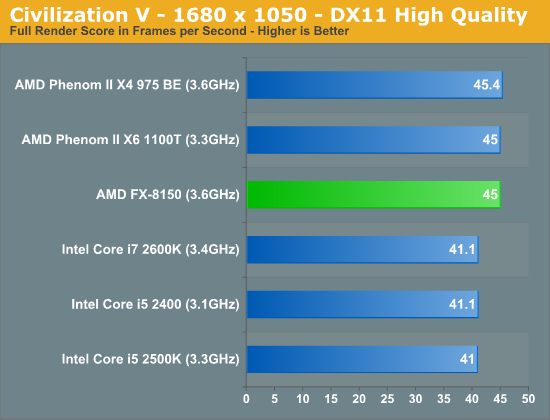
While we're GPU bound in the full render score, AMD's platform appears to have a bit of an advantage here. We've seen this in the past where one platform will hold an advantage over another in a GPU bound scenario and it's always tough to explain. Within each family however there is no advantage to a faster CPU, everything is just GPU bound.
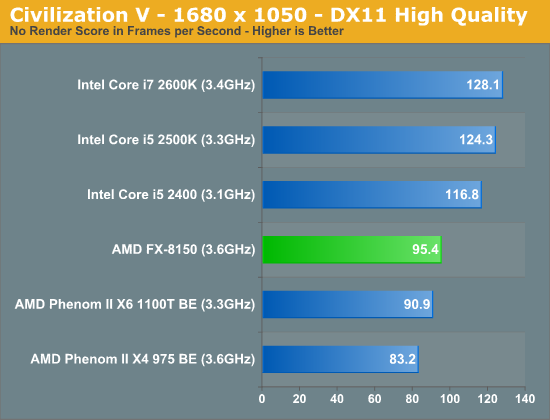
Looking at the no render score, the CPU standings are pretty much as we'd expect. The FX-8150 is thankfully a bit faster than its predecessors, but it still falls behind Sandy Bridge.
Crysis: Warhead
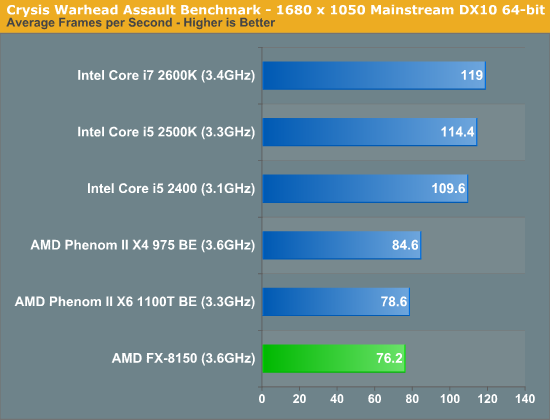
In CPU bound environments in Crysis Warhead, the FX-8150 is actually slower than the old Phenom II. Sandy Bridge continues to be far ahead.
Dawn of War II
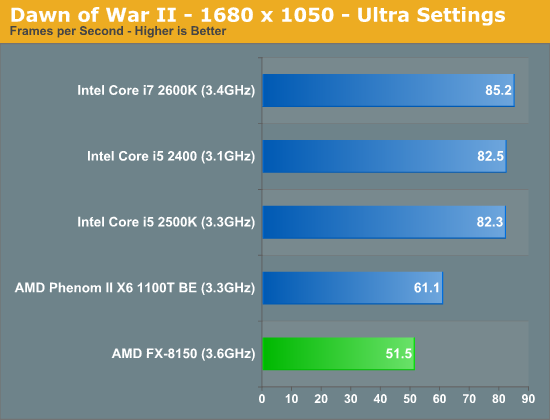
We see similar results under Dawn of War II. Lightly threaded performance is simply not a strength of AMD's FX series, and as a result even the old Phenom II X6 pulls ahead.
DiRT 3
We ran two DiRT 3 benchmarks to get an idea for CPU bound and GPU bound performance. First the CPU bound settings:
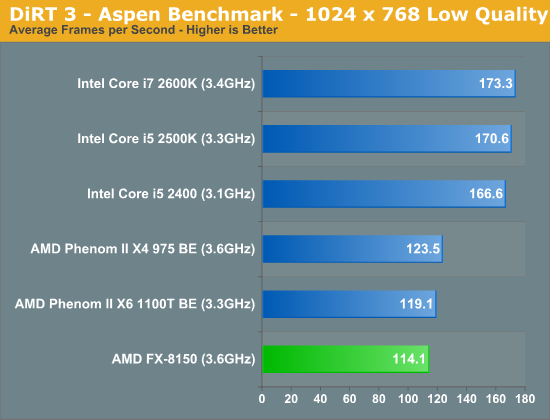
The FX-8150 doesn't do so well here, again falling behind the Phenom IIs. Under more real world GPU bound settings however, Bulldozer looks just fine:
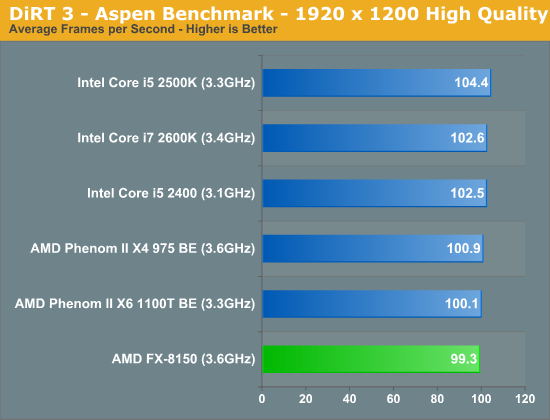
Dragon Age
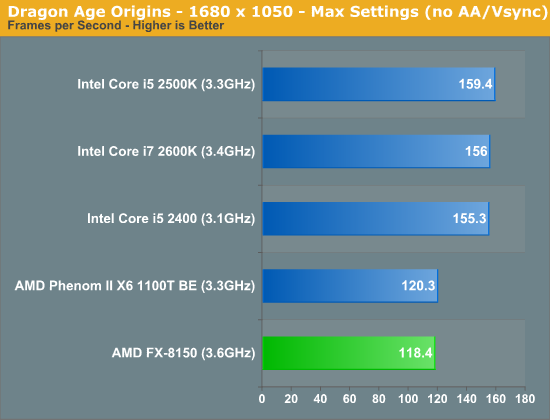
Dragon Age is another CPU bound title, here the FX-8150 falls behind once again.
Metro 2033
Metro 2033 is pretty rough even at lower resolutions, but with more of a GPU bottleneck the FX-8150 equals the performance of the 2500K:
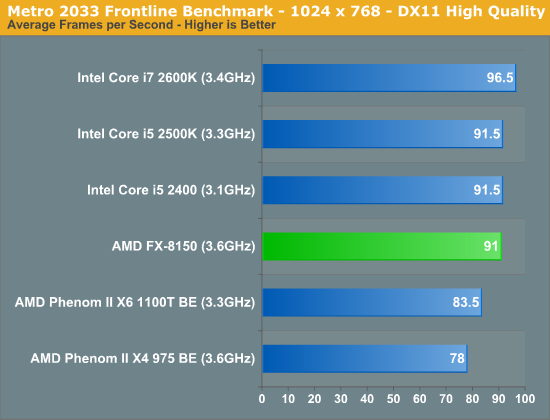
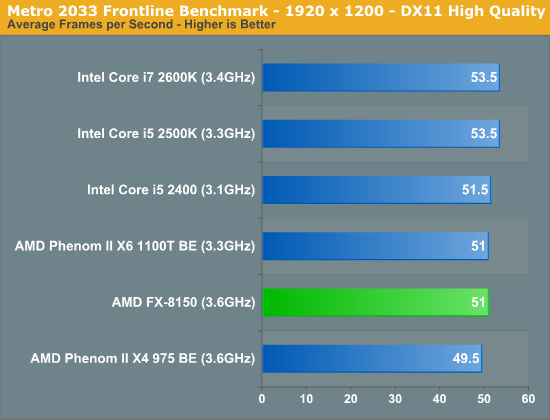
Rage vt_benchmark
While id's long awaited Rage title doesn't exactly have the best benchmarking abilities, there is one unique aspect of the game that we can test: Megatexture. Megatexture works by dynamically taking texture data from disk and constructing texture tiles for the engine to use, a major component for allowing id's developers to uniquely texture the game world. However because of the heavy use of unique textures (id says the original game assets are over 1TB), id needed to get creative on compressing the game's textures to make them fit within the roughly 20GB the game was allotted.
The result is that Rage doesn't store textures in a GPU-usable format such as DXTC/S3TC, instead storing them in an even more compressed format (JPEG XR) as S3TC maxes out at a 6:1 compression ratio. As a consequence whenever you load a texture, Rage needs to transcode the texture from its storage codec to S3TC on the fly. This is a constant process throughout the entire game and this transcoding is a significant burden on the CPU.
The Benchmark: vt_benchmark flushes the transcoded texture cache and then times how long it takes to transcode all the textures needed for the current scene, from 1 thread to X threads. Thus when you run vt_benchmark 8, for example, it will benchmark from 1 to 8 threads (the default appears to depend on the CPU you have). Since transcoding is done by the CPU this is a pure CPU benchmark. I present the best case transcode time at the maximum number of concurrent threads each CPU can handle:
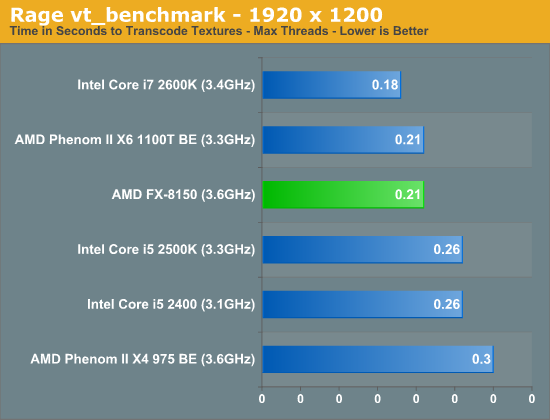
The FX-8150 does very well here, but so does the Phenom II X6 1100T. Both are faster than Intel's 2500K, but not quite as good as the 2600K. If you want to see how performance scales with thread count, check out the chart below:
Starcraft 2

Starcraft 2 has traditionally done very well on Intel architectures and Bulldozer is no exception to that rule.
World of Warcraft
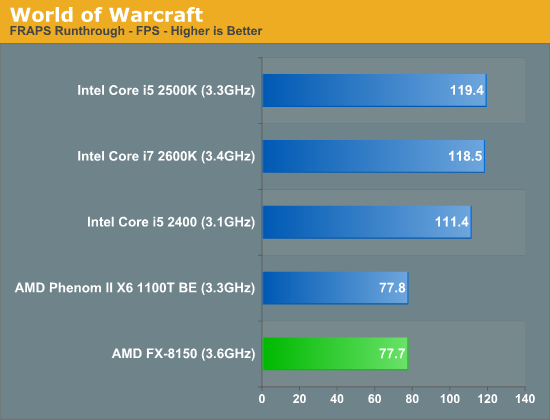


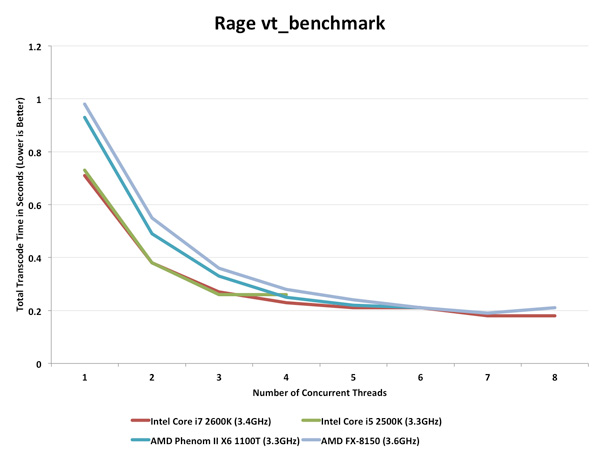








430 Comments
View All Comments
Pipperox - Saturday, October 15, 2011 - link
With a 40-50% gain Bulldozer would be even ahead of Ivy Bridge.. and what comes next.Or are we still talking about SuperPI?
Or games run at 640x480 lowest quality settings?
The fact is, almost all single threaded applications are old and they run already super fast on ANY cpu and the difference can be seen only in benchmarks.
All recent performance demanding applications are properly multithreaded, and Bulldozer there is competitive with i5 2500 and occasionally with i7 2600 (and with a 10% boost Bulldozer would be competitive with i7 2600).
And this will become more and more the standard one year from now.
Sure Bulldozer has not met the enthusiasts' expectations, it doesn't perform as people would expect an "octacore" (but it's not, it's just a quad with a different form of hyperthreading and "clever" marketing) and it doesn't deserve the FX moniker.
But still it's the most competitive CPU AMD has launched in years, perhaps with the exception of Zacate.
nirmv - Saturday, October 15, 2011 - link
Not all applications are heaviliy multi-threaded, there is still need to improve single thread performance.And even for those few loads that are competitive in performance, they do it with twice the power draw.
See here from xbitlabs review :
http://www.xbitlabs.com/images/cpu/amd-fx-8150/pow...
Pipperox - Sunday, October 16, 2011 - link
But increasing single threaded performance has a cost, on die space and circuit complexity.Bulldozer has a huge die just because it has enormous caches (8MB L2 vs 1Mb on SandyBridge) which probably will turn useful on server workloads (but that's just a guess).
By looking at the die shot, you'd get a 40% die area reduction with "normal" caches.
So AMD engineers decided to drop single threaded performance improvements in favor of higher multithreaded scalability and higher clock speed scalability.
We'll see if in the long run this will pay off.
I agree power consumption doesn't look good in comparison with Intel, but it does look good in comparison to Thuban.
This is the first released silicon of Bulldozer.. i expect power consumption to improve with newer steppings and silicon process tuning.
That being said, Intel has the best silicon process in the whole industry.
AMD can't compete with that.
But i'd guess that at lower clock speeds (like in server), AMD's power consumption will improve a lot.
Looks like with the FX AMD tried to push their current silicon to the maximum which they could (within the 125W TDP which is sort of an industry standard).
LiveandEnjoyLife - Friday, October 14, 2011 - link
Some people are missing the point. At this stage in the game, processor speed is a moot point beyond benchmarks. AMD and Intel make very fast CPUs in relation to what gamers and every day users use them for. Intel CPUs are blazing fast and AMD CPUs are fast. The average Joe does need more than a dual-core CPU. If you were going to actually do something that would require heavy multi-threading, then it comes down to the efficiency the app to make use of the cores and the ability to use hyperthreading. If you wanted the most performance for a mult-threaded application, you would pick more physical cores over virtual cores. So for most of use it comes down to bang for buck.8 cores is better than 2, 4, or 6 for true multi-threaded capable applications.
For speed tests Intel wins hands down.
If you were sitting next to someone playing a game and all things were the same except CPU, you would not be able to tell which machine is running what CPU. However you would notice if one costs significantly more than the other.
That is my 4 cents.
7Enigma - Friday, October 14, 2011 - link
Hi Anand,Great review but there is a text error when referring to pass one vs. pass two of the benchmark mentioned in the Subject line. You said:
"The standings don't change too much in the second pass, the frame rates are simply higher across the board. The FX-8150 is an x86 transcoding beast though, roughly equalling Intel's Core i7 2600K. Although not depicted here, the performance using the AMD XOP codepath was virtually identical to the AVX results."
But the graph clearly shows a complete flip-flop from first pass to second pass. When I look closely it appears you ordered the text and graphs differently and were referring to if you had the non-AVX and AVX-enabled graphs next to each other instead of in separate sections. Basically the text and graphs don't match up.
HTH
Iketh - Friday, October 14, 2011 - link
You're an utter retard. The reason they're sold out is newegg advertised these nicely all over their site, including the front page, with "World's first 8-core desktop processor."There are plenty of reasons to purchase these processors aside from their performance and that's ok. But the majority bought them thinking they're gonna "rock", and those are the ones "showing intelligence." Same goes to you for thinking the majority is well-informed/intelligent.
What's even worse, the 8-core version for sale is the 3.1ghz, not the 3.6 tested in this review. I'm seriously LOL'ing...
How many did Newegg have in stock anyhow? Wouldn't that figure matter regarding your ignorant comment?
rcrossw - Friday, October 14, 2011 - link
I have used AMD products for years. I use Intel at work. So to me there is no real difference between the two for what Business and the Average Computer user want or expect.Does it run, does it do the work I require of it, and do my programs and Network Access
work well and are reliable?
Intel indeed has incredible Processors, fast and reliable, and in the high end - expensive.
AMD is Low and Mid range - with processors that the average person can afford. Who is the most innovative - both. Today Intel has been , now I think the user needs to give this New X86-64 Architecture a chance.
I have a Asus M5A99x EVO with an FX6100 installed. The only problem I have had is having to upgrade the BIOS to accept the new Processor. So far I have had the Processor to 4.2 Ghz. Though AIDA 64 caused a BOD on one test. At 3.8 Ghz runs like a champ. Stil
working back to as close as I can get to 4.2 on Air.
After three years I have retired my old Phenon II Tri Core 720 for this, and it works for me.
I am not an extreme gamer, etc. But test it your self, before being too overly critical.
Does it work for me.
As an aside, next a SSD for faster response.
For those interested:
Asus M5A99x MB BIOS 0810 ( Newest)
AMD FX 6100 at 3.8 ghz
Corsair Vengeance 1600 - 16 gigs
HIS Radeon HD 6850
Windows 7 Ulimate 64
HPLP2475W Monitor at 1920x1200 DP
WD 500 SATA
WD 1001 SATA
LG H20L BD-R
Plextor DVDR
Enermax 620 Liberty PS - I know old but works.
Thanks
davbran - Saturday, October 15, 2011 - link
I have been having a hard time writing a comment on this topic without drawing fire from trolls.This review is hogwash without more information.
If the hardware is the same on all test machines, apart from the CPUs, then there is no wonder the performance was so bad. 6 Cores are going to utilize, and I am just pulling a number out of my ... hat, 4gb of RAM more efficiently than an 8 core using simple kitchen math. No need to break out the slide rules. It's a known fact, to most, that the big bottleneck in the multicore/multiprocessor world is memory. Mind you that's if we are factoring in that all the code that was used for testing purposes was written with multi-threading in mind.
You just can't compare apples to bananas in this manner.
silverblue - Saturday, October 15, 2011 - link
Each to their own. I thought it was a pretty good review, and Anand certainly held back from slating AMD to hell.Iketh - Sunday, October 16, 2011 - link
LOLLLLL